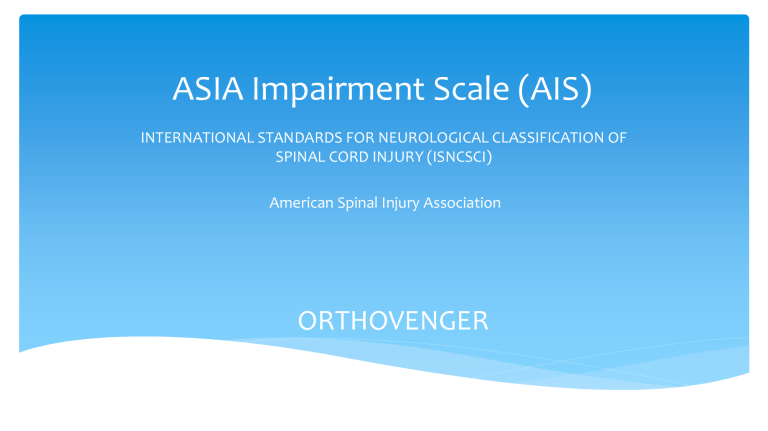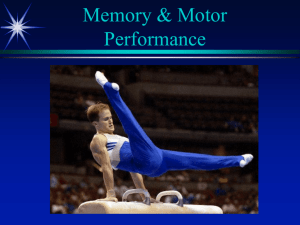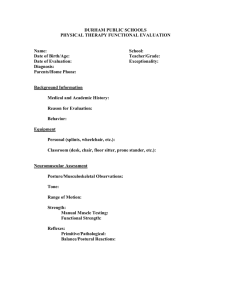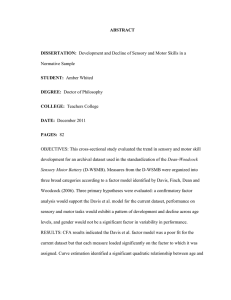ASIA Impairment Scale (AIS) & ISNCSCI Classification
advertisement

ASIA Impairment Scale (AIS) INTERNATIONAL STANDARDS FOR NEUROLOGICAL CLASSIFICATION OF SPINAL CORD INJURY (ISNCSCI) American Spinal Injury Association ORTHOVENGER Steps in Classification The following order is recommended for determining the classification of individuals with SCI. 1. Determine sensory levels for right and left sides. The sensory level is the most caudal, intact dermatome for both pin prick and light touch sensation. Determine sensory levels for right and left sides Sensory Grading 0 = Absent 1 = Altered, either decreased/impaired sensation or hypersensitivity 2 = Normal NT = Not testable (When a key sensory point is not testable for any reason, (i.e. because of a cast, burn, amputation, or if the patient is unable to appreciate sensation on the face) ) 1. Determine sensory levels for right and left sides Light touch sensation is tested with a tapered wisp of cotton stroked once across an area not to exceed 1cm of skin with the eyes closed or vision blocked. Pin prick sensation (sharp/dull discrimination) is performed with a disposable safety pin that is stretched apart to allow testing on both ends; using the pointed end to test for sharp and the rounded end of the pin for dull. patient have to be able to discriminate between sharp and dull sensation at each key sensory point. If in doubt, 8 out of 10 correct answers are suggested as a standard for accuracy; as this reduces the probability of correct guessing to less than 5%. The inability to distinguish between dull and sharp sensation (as well as no feeling when being touched by the pin) is graded as 0. 2. Determine motor levels for right and left sides. Testing of key muscle functions corresponding to 10 paired myotomes (C5-T1 and L2-S1) It should be examined in a rostral-caudal sequence standard supine positioning Improper positioning and stabilization will not accurately reflect the muscle function being graded. When examining a patient with a suspected acute traumatic injury below the T8 level, the hip should not be allowed to actively or passively flex beyond 90° due to the increased kyphotic stress placed on the lumbar spine. Examination should be performed isometrically and unilaterally, so that the contralateral hip remains extended to stabilize the pelvis. Muscle Function Grading 0 = total paralysis 1 = palpable or visible contraction 2 = active movement, full range of motion (ROM) with gravity eliminated 3 = active movement, full ROM against gravity 4 = active movement, full ROM against gravity and moderate resistance in a muscle specific position 5 = (normal) active movement, full ROM against gravity and full resistance in a functional muscle position expected from an otherwise unimpaired person 5* = (normal) active movement, full ROM against gravity and sufficient resistance to be considered normal if identified inhibiting factors (i.e. pain, disuse) were not present NT = not testable (i.e. due to immobilization, severe pain such that the patient cannot be graded, amputation of limb, or contracture of > 50% of the normal ROM) C5 –Elbow flexors (biceps, brachialis) C6 –Wrist extensors (extensor carpi radialis longus and brevis) C7 –Elbow extensors (triceps) C8 –Finger flexors (flexor digitorum profundus) to the middle finger T1 – Small finger abductors (abductor digiti minimi) L2 – Hip flexors (iliopsoas) L3 – Knee extensors (quadriceps) L4 –Ankle dorsiflexors (tibialis anterior) L5 –Long toe extensors (extensor hallucis longus) S1 – Ankle plantar flexors (gastrocnemius, soleus) Hoppenfeld, H., 1976. Physical Examination of the Spine. Appleton-Century-Crofts, New York. L2 Hoppenfeld, H., 1976. Physical Examination of the Spine. Appleton-Century-Crofts, New York. 3. Determine the neurological level of injury (NLI) This refers to the most caudal segment of the cord with intact sensation and antigravity (3 or more) muscle function strength, provided that there is normal (intact) sensory and motor function rostrally respectively. The NLI is the most cephalad of the sensory and motor levels determined in steps 1 and 2. 4. Determine whether the injury is Complete or Incomplete absence or presence of sacral sparing If voluntary anal contraction = No AND all S4-5 sensory scores = 0 AND deep anal pressure = No, then injury is Complete. Otherwise, injury is Incomplete. Deep Anal Pressure (DAP): Insert the examiners index finger and applying gentle pressure to the anorectal wall (innervated by the pudendal nerve S4/5). Alternatively, pressure can be applied by using the thumb to gently squeeze the anus against the inserted index finger. Consistently perceived pressure should be graded as being present or absent (i.e., enter Yes or No on the worksheet). Any reproducible pressure sensation felt in the anal area during this part of the exam signifies that the patient has a sensory incomplete lesion. The rectal examination is still required however, to test for motor sparing (i.e. voluntary anal sphincter contraction). Voluntary anal contraction (VAC) Check on the voluntary contractions around the examiner’s finger and graded as being present or absent (i.e., enter YES or NO on the patient’s worksheet). The instruction to the patient should be “squeeze my finger as if to hold back a bowel movement”. If there is VAC present, then the patient has a motor incomplete injury. Care should be taken to distinguish VAC from reflex anal contraction; if contraction can be produced only with Valsalva maneuver, it may be indicative of reflex contraction and should be scored as absent. Determine ASIA Impairment Scale (AIS) Grade: Is injury Complete? If YES, AIS=A and can record ZPP (lowest dermatome or myotome on ech side with some preservation) NO Is injury Motor Complete? If YES, AIS=B (No=voluntary anal contraction OR motor function more than three levels below the motor level on a given side, if the patient has sensory incomplete classification) NO Are at least half (half or more) of the key muscles below the neurological level of injury graded 3 or better NO AIS = C YES AIS = D If sensation and motor function is normal in all segments, AIS=E Note: AIS E is used in follow-up testing when an individual with a documented SCI has recovered normal function. ASIA Impairment Scale (AIS) A = Complete. No sensory or motor function is preserved in the sacral segments S4-5. B = Sensory Incomplete. Sensory but not motor function is preserved below the neurological level and includes the sacral segments S4-5 (light touch or pin prick at S4-5 or deep anal pressure) AND no motor function is preserved more than three levels below the motor level on either side of the body. ASIA Impairment Scale (AIS) C = Motor Incomplete. Motor function is preserved at the most caudal sacral segments for voluntary anal contraction (VAC) OR the patient meets the criteria for sensory incomplete status (sensory function preserved at the most caudal sacral segments (S4-S5) by LT, PP or DAP), and has some sparing of motor function more than three levels below the ipsilateral motor level on either side of the body. (This includes key or non-key muscle functions to determine motor incomplete status.) For AIS C – less than half of key muscle functions below the single NLI have a muscle grade ≥ 3. ASIA Impairment Scale (AIS) D = Motor Incomplete. Motor incomplete status as defined above, with at least half (half or more) of key muscle functions below the single NLI having a muscle grade ≥ 3. E = Normal. If sensation and motor function as tested with the ISNCSCI are graded as normal in all segments, and the patient had prior deficits, then the AIS grade is E. Someone without an initial SCI does not receive an AIS grade. refferences Hoppenfeld, H., 1976. Physical Examination of the Spine. AppletonCentury-Crofts, New York. Kirshblum, S.C., Burns, S.P., Biering-Sorensen, F., Donovan, W., Graves, D.E., Jha, A., Johansen, M., Jones, L., Krassioukov, A., Mulcahey, M.J. and Schmidt-Read, M., 2011. International standards for neurological classification of spinal cord injury (revised 2011). The journal of spinal cord medicine, 34(6), pp.535-546.



